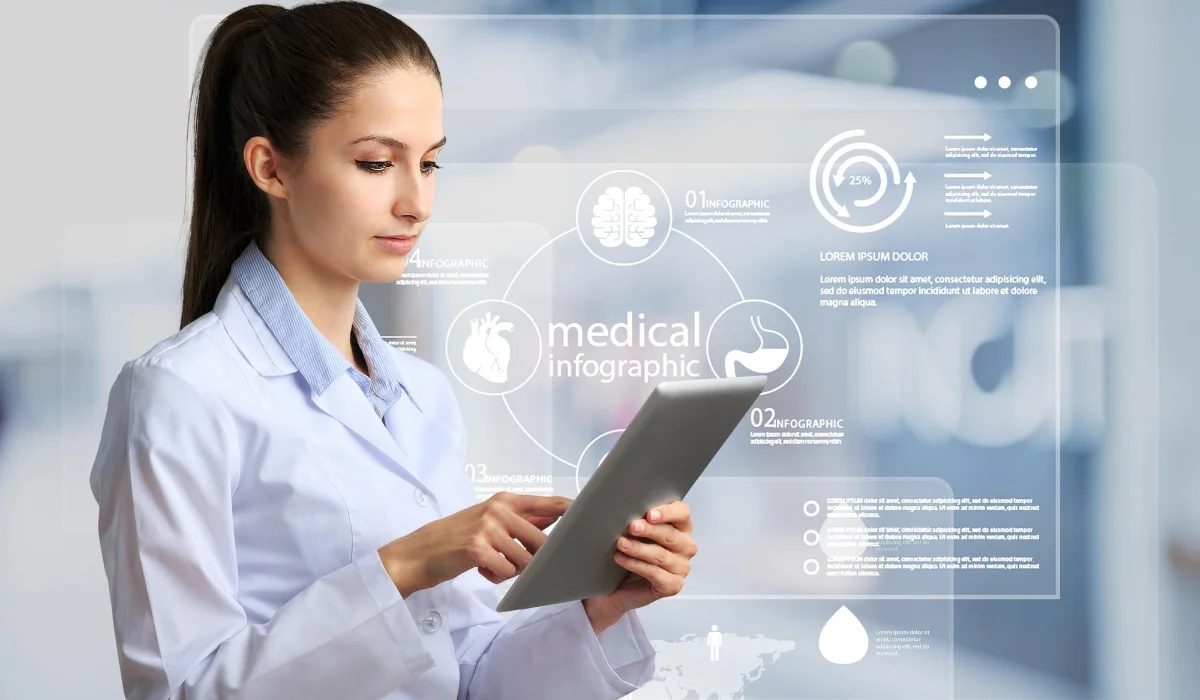Predictive Analytics in Healthcare: A Shift to Preventive Care
- SoftudeOctober 15, 2024
- Last Modified onNovember 22, 2024
Having so much data at your fingertips but not being able to use it is a waste. Predictive analytics in healthcare make this data wealth useful and open ways for preventive care, accurate diagnosis, and give hints to reduce cost. How exactly does it contribute, and what does it mean for you? In our blog, we will explore everything about predictive analytics.

Predictive analytics is a part of data analytics and includes the use of machine learning techniques, data mining, and modeling. Both historical and real-time data are used to generate insights about current and future scenarios. This data usually includes medical records, health surveys, patient diagnosis and treatment, etc.
Value-based care depends on this pillar of data. However, the unstructured and fragmented data in healthcare organizations pose a challenge. Artificial intelligence is solving this problem.
How Does Predictive Analytics Promote Preventive Care
So far, the healthcare industry has followed reactive care. Patients get treatments after developing a disease. Half of them are unaware of the symptoms and reach hospitals when they are at the final stage. The last-stage treatment is less effective and thus reduces their chances of survival.
AI in preventive healthcare focuses on preventive/proactive care where diseases are detected and prevented early. Managing high-risk diseases in patients is easy this way where doctors can treat patients with low-cost treatments and diets. It also saves patients’ money and time on expensive screenings, tests, and routine check-ups.
Predictive analytics make this new form of care highly impactful through personalization. It provides insights into each patient’s current and previous medical history to understand how their health will be affected. Let us discuss its role in detail.
Also Read: Generative AI Vs Predictive AI
The Role of Predictive Analytics in Preventive Care
1. Risk Stratification
In diabetic patients or those with a family history, not everyone will develop type-1 or type-2 diabetes despite being at risk. Differentiating those at higher risk and those who will take time is essential to meet urgent care needs and reduce the risk of complications.
Predictive analytics helps in risk stratification by analyzing diverse data, such as age, lifestyle choices, and genetics. Based on this data, AI predictive models can accurately assess those who need immediate interventions.
2. Personalized Treatment Plans
Predictive analytics is the first step towards precision medicine. AI models can create personalized treatment and diet plans to reduce the risk factors among patients early. For example, a patient likely to develop heart disease may reduce the risks by making dietary changes, regularly monitoring cholesterol, or taking preventive medications.
3. Reducing Hospital Readmissions
Hospital readmissions are costly not only for patients but also for the hospitals. Readmissions indicate the inefficiency of hospital services and treatments. However, they are unavoidable in some cases.
Predictive analytics can save patients from expensive treatments and hospitals from the burden of repeat patients. Doctors can use data from EHRs to identify which patients need readmissions and make arrangements such as follow-up appointments, bed availability, etc.
4. Optimizing Healthcare Resources
When COVID-19 hit, hospitals and clinics ran out of beds and medical supplies. In such scenarios, predictive analytics can prove useful for balancing healthcare resources with patient demand.
For instance, hospitals can use AI-powered predictive models to estimate the estimated traffic in emergency departments or inventory resources.
They can more efficiently plan and allocate staff, equipment, and beds. This prior planning will optimize resources, reduce wait times, and improve patient care.
5. Predicting Side Effects of Drug
AI in preventive healthcare is about more than early disease detection or personalized treatments. Understanding how particular medicines will react to the patients’ bodies, especially when new drugs are suggested, is an important aspect of preventive care.
Machine learning algorithms have proven effective in analyzing the interaction between drugs and the human body. This is beneficial, especially if the patient has an allergy to certain compounds.
By having this knowledge early on, doctors can suggest medicines that will positively affect patients rather than causing side effects.
The use of AI in public health goes beyond preventive care. It can be used in the following areas as well:
- Identify which insurance claims that do not meet the criteria.
- Predict the suicide tendency in the patients by analyzing their social and economic conditions besides medical records.
- Forecast no-shows and reduce administrative burden and cost that come with last-minute cancellation of appointments.
- Strengthen healthcare cybersecurity with AI and detect possibilities of data breaches.
- Predict possible disease outbreaks in high-risk areas or those with limited healthcare services.
The Process Behind Predictive Analytics in Healthcare

To fully utilize AI in preventive healthcare, it is important to understand what happens behind the scenes. Let’s understand the process of predictive modeling, also known as predictive analytics.
- It starts with collecting data from every possible source that could impact predictive analytics results.
- The data is usually in a non-standard format and fragmented because different healthcare solutions use data in different ways. The next step is to clean, process, and standardize the data to bring uniformity.
- In the third step, a common relationship between different variables is established to understand how each data point is relatable and will influence the decision. This step forms the basis of predictive analytics.
- If you use a pre-built AI model, the next step involves data feeding. Otherwise, a predictive model is built for the intended task.
- Different algorithms are run on the model to test its output. This process also includes refining the data to meet the desired output.
- Model testing and deployment is the last step.
Don’t worry; the expert will perform all these steps. You only need to find an expert machine learning model development company to incorporate predictive analytics. They will also take care of model maintenance to update the results as per the latest data.
Conclusion
Data will grow in the healthcare industry every day, every year. Only those who understand the data well and use predictive analytics in healthcare can reap its benefits and grab the opportunities it brings. From proactive care to hospital management, AI-powered analytics are applicable everywhere.
Softude is always ready to help you with our data analytics and AI capabilities. Whether you are a health tech startup or a medical facility manager, we help you develop AI-powered healthcare solutions. Feel free to discuss your requirements with us, and our experts will get back to you.
Liked what you read?
Subscribe to our newsletter








.png)



